P-90 pickups are often categorized as the tonal bridge between humbuckers and single-coil pickups. Originally produced by Gibson before the inception of the humbucker, P-90s offer a player a tone that is warm and also raspy when driven, yet tend to be brighter than a humbucker. Many players see this as a combination of the more desirable qualities of both humbucker and single coil pickups.
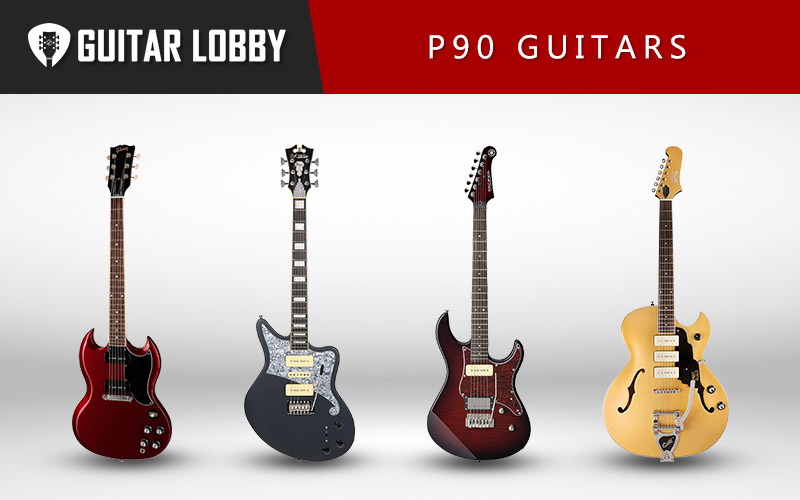
Technically a P-90 pickup is a “single-coil”, however, their design differences and tonal properties make it impossible to consider them the same category. P90 pickups prevalently used and often favored in many different musical genres. Over the years I’ve tested dozens of guitars with P90 pickups, and in this article, I’ll be sharing the best P90 guitars at each price point.
| Name of Product | Image of Product | Description | Price Range | Full Review |
|---|---|---|---|---|
| 1. D’Angelico Premier Bob Weir Bedford (Best Under $1000) | 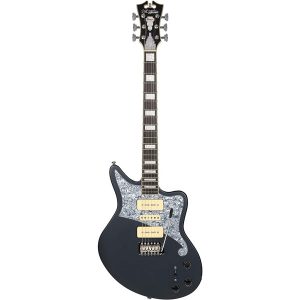 | Body type: Solid body, “offset” design Body material: Basswood | $1000 | Read Full Review Below |
| 2. Squire Classic Vibe 60s Jazzmaster (Best Under $500) | 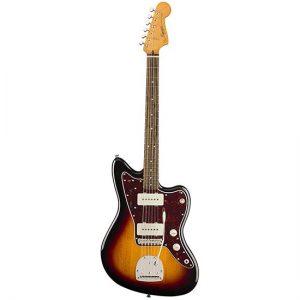 | Body type: Solid, double-cutaway, offset Body material: Mahogany | $430 | Read Full Review Below |
| 3. Guild Guitars Starfire I Jet 90 (Best Value Semi-Hollow) | 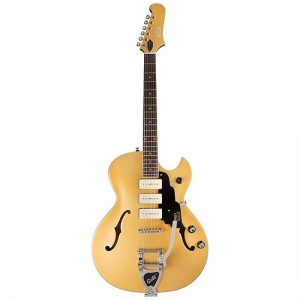 | Body type: Semi-hollow body, single-cutaway Body material: Maple | $650 | Read Full Review Below |
| 4. Epiphone SG Special P90 (Budget Pick) | 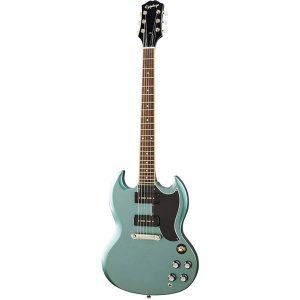 | Body type: Solid, double-cutaway Body material: Mahogany | $400 | Read Full Review Below |
| 5. Gibson Les Paul Standard 1950s P90 (Editor's Choice) | 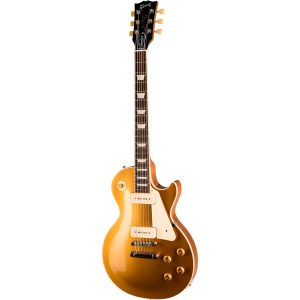 | Body type: Solid, single-cutaway Body material: Mahogany, maple | $2500 | Read Full Review Below |
| 6. Gibson SG Special | 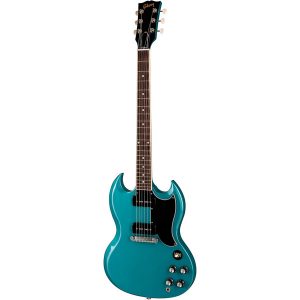 | Body type: Solid body, double-cutaway Body material: Mahogany | $1500 | Read Full Review Below |
| 7. Yamaha Pacifica PAC611 | 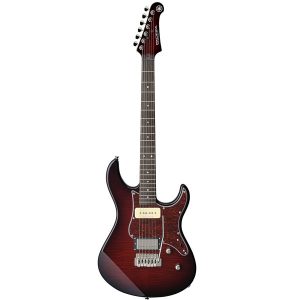 | Body type: Solid body, Strat-style double-cutaway Body material: Alder | $600 | Read Full Review Below |
| 8. Guild Guitars M-75 Aristocrat | 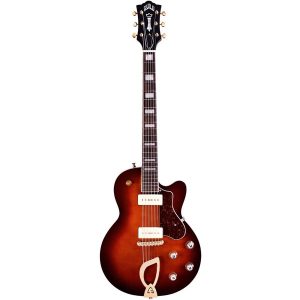 | Body type: Hollow body, single-cutaway Body material: Spruce and mahogany | $800 | Read Full Review Below |
| 9. Prestige Guitars NYS Deluxe MG | 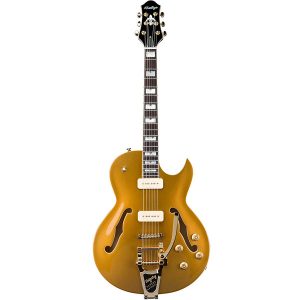 | Body type: Semi-hollow body, single-cutaway Body material: Maple | $1240 | Read Full Review Below |
| 10. Epiphone Wilshire | 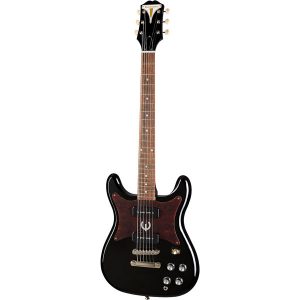 | Body type: Solid, double-cutaway Body material: Mahogany | $500 | Read Full Review Below |
| 11. Godin 5th Avenue Kingpin P90 |  | Body type: Hollow, no cutaways Body material: Canadian wild cherry | $700 | Read Full Review Below |
| 12. Gibson Les Paul Special | 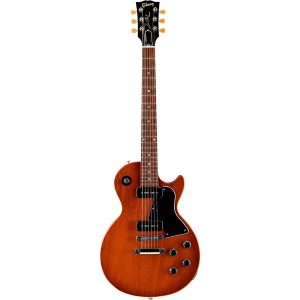 | Body type: Solid, single-cutaway Body material: Mahogany | $1200 | Read Full Review Below |
| 13. Malinoski HiTop P90 | 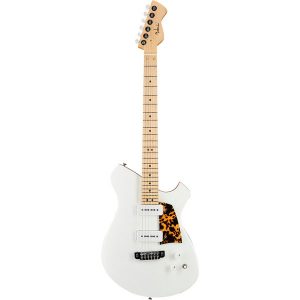 | Body type: Solid, “offset” double-cut Body material: Mahogany | $3000 | Read Full Review Below |
| 14. Epiphone Casino | 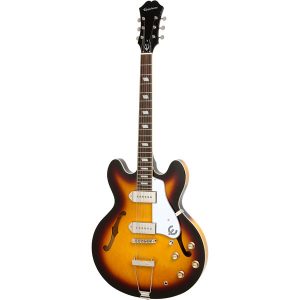 | Body type: Hollow, double-cutaway Body material: Maple | $650 | Read Full Review Below |
| 15. Fender Noventa Jazzmaster | 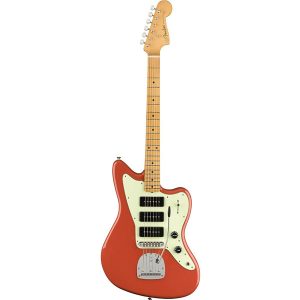 | Body type: Solid, Jazzmaster shape Body material: Alder | $1150 | Read Full Review Below |
| 16. Fender Player Mustang 90 | 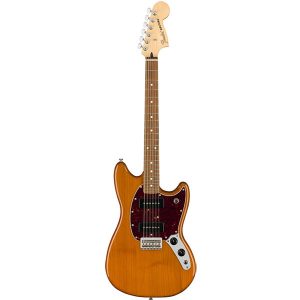 | Body type: Solid, Mustang Body material: Alder | $650 | Read Full Review Below |
| 17. Fender Noventa Stratocaster | 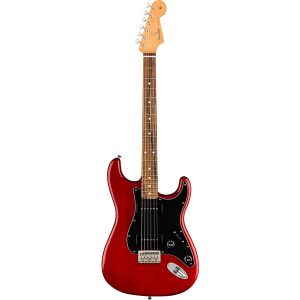 | Body type: Solid, Stratocaster Body material: Alder | $1050 | Read Full Review Below |
Here Are the Best P90 Guitars
1. D’Angelico Premier Bob Weir Bedford (Best Under $1000)
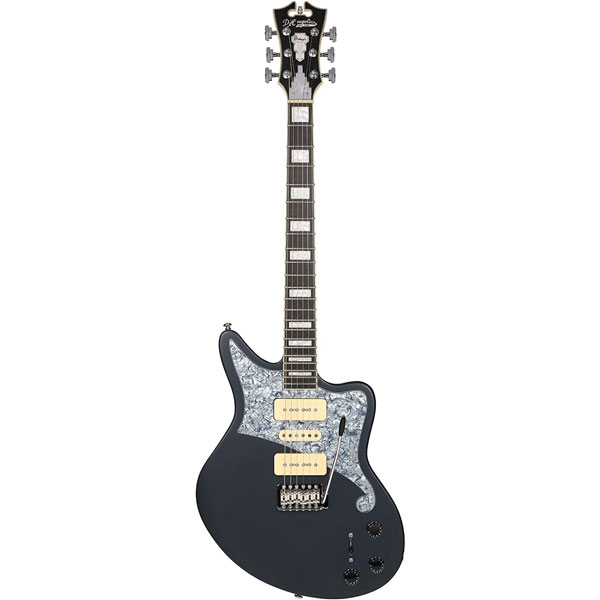
| Estimated Price | $1000 |
| Body type | Solid body, “offset” design |
| Body material | Basswood |
| Neck material | Maple |
| Frets | 22 |
| Bridge type | 6-point tremolo bridge |
My Review: D’Angelico is known for delivering some of the most impressive gear, fusing old school designs and principles with some of the modern demands of contemporary virtuosos. That’s also the case with D’Angelico Premier Bob Weir Bedford guitar, which combines prestigious vintage looks, great tone, and overall great ergonomic qualities.
So let’s start with the main topic here, which is the P90 pickups. We’ve already seen guitars that have a P90 and humbucker combo on them. However, the Premier Bob Weir Bedrord model comes with a rather unusual formation of pickups.
There are two Seymour Duncan P90s, one in the neck and one in the bridge position. However, there’s also an additional single-coil pickup in the middle position. This is an SC-101 by Seymour Duncan, giving that much-needed brightness to the mix. This is all accompanied by a 5-way pickup selector switch, as well as interesting controls. Aside from master volume and master tone knobs, there’s also a “blend” control.
This gives you the option to add the signal from a P90 pickup that’s not selected. And just imagine the sonic possibilities here. This is especially useful for clean and overdriven tones on tube amps where all the nuances between the pickup combinations and other settings can be heard.
The other aspects of this guitar are also worth our every praise. The body shape brings that classic “offset” body shape, very similar to Fender’s classic Jazzmaster guitar. Made out of basswood, the backside of the body, right where the cutaways are, features a well-designed slope that allows very comfortable access to higher frets.
In combination with the set-through body and neck design, it makes for one really easy-to-play guitar.
While we’re at it, the guitar features a wonderful maple neck with a classic “C” profile, as well as an ovangkol fingerboard. Then there’s also a pretty flat fretboard radius of 14 inches. This is all accompanied by a 6-point tremolo bridge which allows for a lot of control for any kind of vibratos that you need.
Things are all rounded up with an instrument’s awesome design. The headstock really makes it stand out, but the addition of fretboard binding, block inlays, Grover Rotomatic Stairstep tuning machines, as well as the instrument’s finish and pickguard give it a really unique look.
The guitar is mostly intended for bluesy, jazzy, and psychedelic-inspired stuff. However, you’d be surprised at what D’Angelico Premier Bob Weir Bedford is capable of. Overall, I would say this is the best P90 guitar under 1000 dollars.
2. Squire Classic Vibe 60s Jazzmaster (Best Under $500)
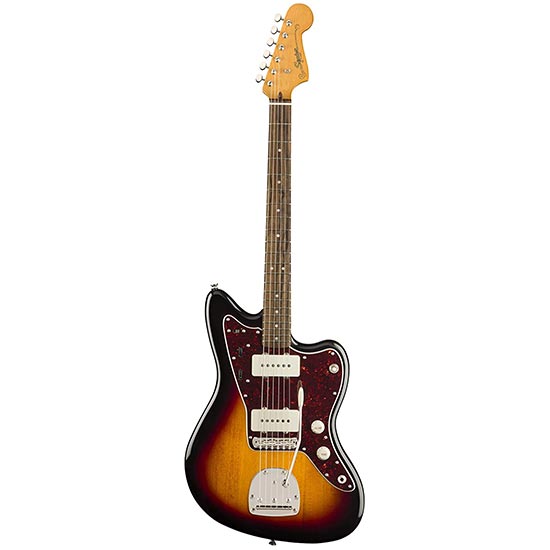
| Estimated Price | $430 |
| Body type | Solid, double-cutaway, offset |
| Body material | Poplar |
| Neck material | Maple |
| Frets | 22 |
| Bridge type | Tremolo |
My Review: When I first got this guitar my first thought was that although it’s a Squire, it feels a lot like a Fender. The finish and feel were on par with most Fender “made in Mexico” models I’ve ever owned, tested, or reviewed. There was a time when the Jazzmaster model was a controversial and downright divisive design for Fender, but a surge in popularity for offset shape guitars has players looking for more quality and value options.
This particular Jazzmaster checks those boxes and comes loaded with 2 P90 style pickups, which makes it an incredible value buy on this list as one of the best p90 guitars under $500. It is worth noting that these are not technically “P90” pickups as P90 is an old Gibson single-coil pickup design you’ll never hear fender refer to any of their pickups as P90s. However, what this Jazzmaster is equipped with is a Fender-designed P90 style pickup design that replicates all the tonal qualities we are looking for from our P90s.
3. Guild Guitars Starfire I Jet 90 (Best Value Semi-Hollow)
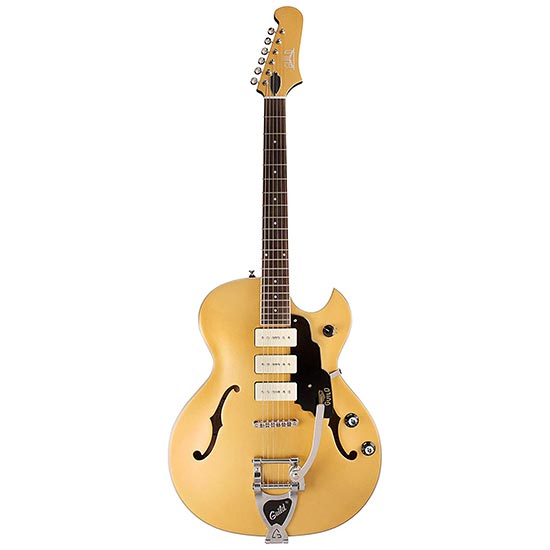
| Estimated Price | $650 |
| Body type | Semi-hollow body, single-cutaway |
| Body material | Maple |
| Neck material | Mahogany |
| Frets | 20 |
| Bridge type | Tune-o-matic with Bigsby-style tremolo tailpiece |
My Review: Guild Guitars is also a company that’s somewhat underrated, at least within the mainstream guitar-playing population. And those who know about Guild usually remember the company for their super expensive stuff. However, they also offer some incredible value guitar models, like the Starfire I Jet 90.
As you can notice immediately, this is a semi-hollow-body guitar, featuring the classic single-cutaway design. It’s a very vintage-looking piece, and its overall performance qualities are what the company was aiming for. There’s the maple body with a solid mahogany center block, as well as an arched top with “F”-shaped soundholes.
The instrument’s design is also enhanced with amazing-looking binding on the edge of the body and the fretboard.
The guitar comes in three main finish variants, satin black, satin white, and satin gold. The gold and black variants feature a black back and sides, while the white one features the same color all over.
Then there’s also the standard tune-o-matic bridge. However, it’s paired up with a vintage-inspired Guild tremolo tailpiece, completely in the style of old Bigsby tremolos. But it comes with a rather unique visual appearance with the 6-in-line headstock.
Its performance characteristics are also pretty great within this particular price level. The guitar’s mahogany neck features a modern-oriented “Thin U” profile, while the Indian rosewood fretboard has a radius of 12.5 inches.
But what we’re here for are the P90 pickups. And in the case of Guild Starfire I Jet 90, we have three of them. These are Guild’s own Franz P90 variants, which rely on the same classic principles but also provide players with just a dash of that modern-sounding “edge.”
There are the standard master volume and master tone controls. But it’s all also accompanied by a 6-way rotary selector switch that looks like a knob and that’s located near the instrument’s cutaway.
There are the five standard positions that you’d expect from any standard guitar that has three single-coil pickups. But the sixth combination fires up the neck and the bridge pickup, giving one more way for you to change your tone.
Although a semi-hollow-body guitar that seems like a classic blues or jazz instrument, Starfire I Jet 90 is more than that. Combined with its aesthetic features, it can really be useful for classic rock, rockabilly, and even some hard rock when implemented properly. And on top of all this, the guitar is not expensive at all, despite bringing some pro-level qualities. In my opinion, this is the best P90 guitar for the money right now.
4. Epiphone SG Special P90 (Budget Pick)
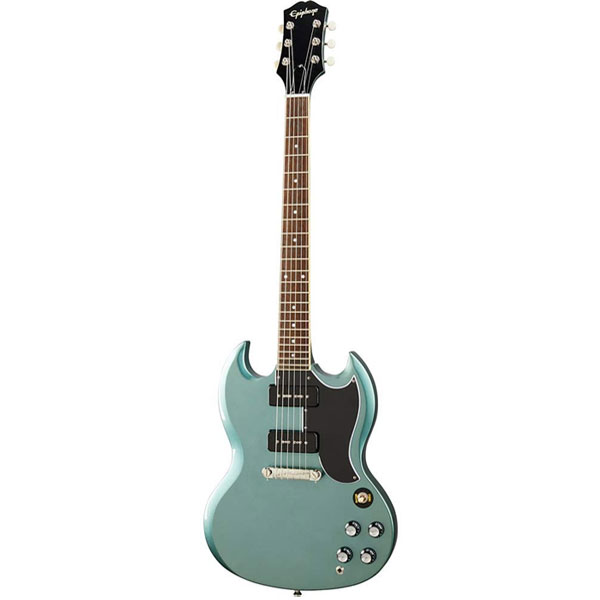
| Estimated Price | $400 |
| Body type | Solid, double-cutaway |
| Body material | Mahogany |
| Neck material | Mahogany |
| Frets | 22 |
| Bridge type | Wraparound |
My Review: Sure, a lot of guitar players complain about how Gibson is too expensive. While we can push this discussion into oblivion, the simplest solution to everyone who likes Gibson guitar designs but doesn’t have the budget is to check out Epiphone. I’ve played dozens of these new Epiphone guitars and own several, and let me put it to you simply, these new Epiphone guitars are incredible guitars.
For this list, we’re bringing their simple, affordable, yet super awesome SG Special. Of course, the variant in question is loaded with P90 pickups and it’s way ahead of Epiphone’s super-basic SG Special with stock humbucker pickups.
The most important thing to note here is that the body design is exactly the same as with regular Gibson SG models. And compared to the cheapest variant of Epiphone’s Special series is that this particular one comes with set-neck construction.
There are two P90 pickups, the Epiphone’s P90 Pro edition. They’re controlled through the standard 3-way pickup selector switch, as well as the four standard knobs (two for volume and two for tone).
We all know that these “Special” variants are usually very simple and to the point. One of the traits is the simple “wraparound” bridge, which is essentially a standalone tailpiece. However, what’s different about this SG variant is that the tailpiece comes with simplified rudimentary string saddles.
This one’s called the “Lightning Bolt” wraparound bridge, something that was typical of old Gibson guitars from the 1960s.
The neck was pretty interesting as well. Although mostly inspired by vintage stuff, this is a slightly more modern variant of the ’60s SlimTaper profile. The Indian laurel fretboard also features a radius of 12 inches, which is the standard deal with Gibson and Epiphone guitars.
In the end, what surprises us the most about Epiphone’s SG Special P90 is that it feels almost exactly the same as a Gibson. Some would even say that there’s no difference at all, and we understand why that’s the case.
Be that as it may, for such a low price, you’ll get a pretty awesome yet simple guitar. Sure, it lacks some features and it may not be as highly functional as some other examples here. But, in our opinion, the guitar works way better than most of the stuff in this price range.
Plus, the finish options make it look pretty awesome and unique.
5. Gibson Les Paul Standard ’50s P90 (Editor’s Choice)
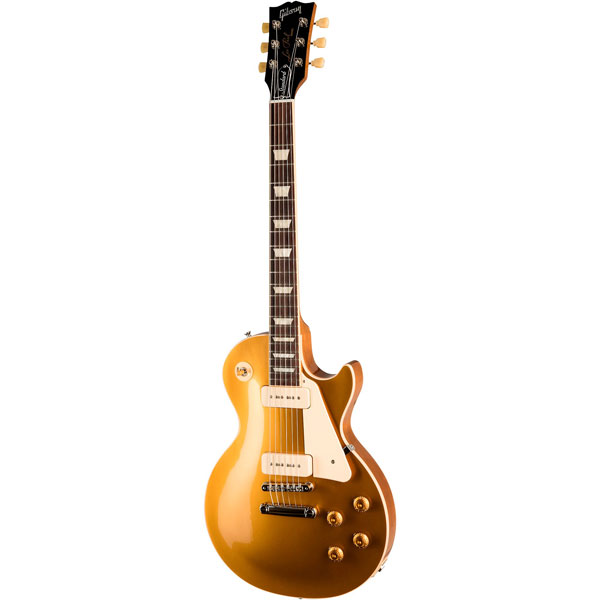
| Estimated Price | $2500 |
| Body type | Solid, single-cutaway |
| Body material | Mahogany, maple |
| Neck material | Mahogany |
| Frets | 22 |
| Bridge type | Tune-o-matic |
My Review: When talking about P90 pickups, it’s impossible not to mention the old Les Paul Standard guitars from the 1950s. Knowing the greatness and the impact that these guitars have made, it was only obvious that Gibson would do a sort of a “re-release” of these old guitar models.
But in their essence, these are a bit more stylish Les Paul Standard models with P90 pickups, some serious 1950s aesthetic vibes, and a classic gold finish. The gold-top with P90 pickups is how some of the very first Gibson Les Paul guitars started back in 1952.
Of course, these reissued ’50s Les Pauls aren’t exactly the cheapest guitars around. So if you’re a beginner or an intermediate player on a limited budget, it’s not something that would work for you. But on the other hand, this is one of the best P90 guitar models that you can find on the market today.
And they’re pretty authentic to the original 1950s spec, which is what Gibson often aims for. The classic spec builds typically consist of a mahogany body with a maple top and a set-in mahogany neck with a rosewood fingerboard. All of the other classic features are there aswell, including the regular 24.75-inch scale length, 22 medium-jumbo frets, and a 12-inch fretboard radius.
Finally, the pickups are controlled with the regular 4-knob configuration and a pickup selector switch. Aside from the golden-painted top, we have its other great aesthetic features, including the binding on the body and neck, natural-finish back and sides, as well as the trapezoid pearl inlays on the fingerboard.
But what makes the Les Paul Standard with P90 pickups stand out compared to the Les Paul Special? Firstly, the guitar simply feels much different. In addition, the tone is a bit fuller, which is due to the instrument’s overall build and use of materials. While there are obvious similarities, the ’50s reissue Standard is way above the Special in all aspects.
In short, this guitar will get you covered for an abundance of musical styles. Anything from classic old-school blues and up to heavy metal, this Les Paul can do it. And it’s the closest thing that you can get to those classic 1950s Les Paul models.
6. Gibson SG Special
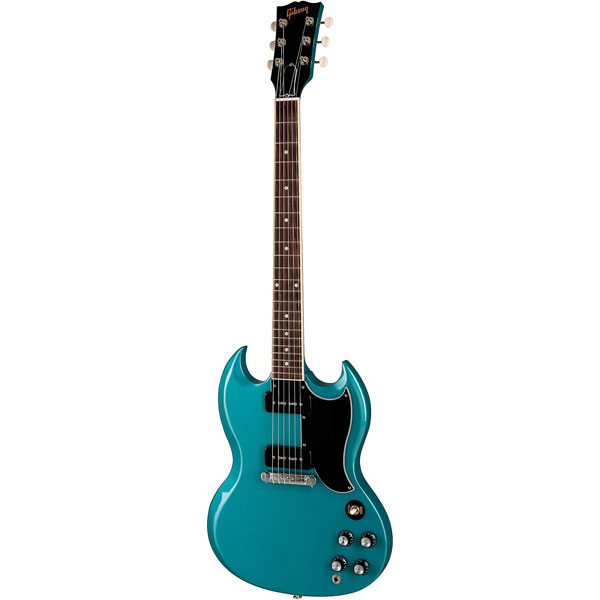
| Estimated Price | $1500 |
| Body type | Solid body, double-cutaway |
| Body material | Mahogany |
| Neck material | Mahogany |
| Frets | 22 |
| Bridge type | Compensated wraparound bridge |
My Review: One of the most legendary electric guitars of all time is Gibson’s SG Special model. Starting back in the 1960s, this instrument is still in production. The basic design and principles are the same, although there are always some slight variations.
However, what stayed the same with most of the variants is the inclusion of the good old P90 pickups. A similar model is also the SG Junior, which comes with just one P90 pickup in the bridge position, but there are also some other similarities depending on the exact version.
But to get back to the SG Special models, these guitars bear all of the basic SG characteristics and are stripped-down versions of this old legendary guitar model. Now, just because they’re basic doesn’t mean that they’re not as effective. You’ll just notice the differences in its visual design and a few other traits that make it simple.
First off, this instrument has the classic mahogany body, paired up with its mahogany neck that carries the standard rosewood fretboard.
The body and the neck, of course, form the regular set-neck construction. Combined with the overall thin body design, these guitars allow for really easy access to higher frets. There are also other classic Gibson traits, like the angled headstock.
Some variants these days also include binding on the fretboard, making the guitar look more attractive. But other than that, you’ll only find the regular pearl dot inlays on the fretboard.
Finally, the most popular version of this guitar comes with a pair of P90 pickups. This is accompanied by the standard 3-way pickup selector switch, as well as two volume and two tone controls. The SG Special also often comes with a “compensated” version of a simple wraparound bridge that’s essentially like a modified tailpiece.
Bottom Line: Although simple, this guitar can be very potent. The overall vintage feel, along with its simplicity, is usually really popular among rock and punk rock players. But don’t let this trick you into thinking that the instrument can’t be useful for more technically challenging stuff.
It’s really easy to play, it feels great, and you can also see it in hands of blues, hard rock, and even jazz players. Although Gibson SG Special isn’t that popular among “shredder” kind of players, it can serve as a great virtuoso tool as well. It’s a very simple and underrated instrument.
7. Yamaha Pacifica PAC611
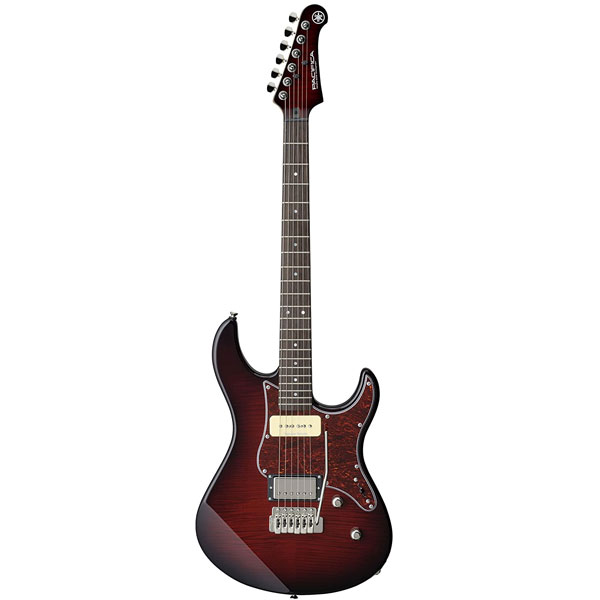
| Estimated Price | $600 |
| Body type | Solid body, Strat-style double-cutaway |
| Body material | Alder |
| Neck material | Maple |
| Frets | 22 |
| Bridge type | Wilkinson VS50-6 |
My Review: If there’s one company that sells the best possible stuff within the mid-range price category, we’d say that it’s Yamaha. In fact, we’re often baffled at the fact by how affordable and underrated their Pacifica series guitars are, especially considering all the qualities that you get. The one model that stood out to us here is the Yamaha Pacifica PAC611.
Now, what makes it kind of different is that it comes with one P90 pickup and one humbucker. The P90 is in the neck position, giving those smooth and round tones with that noticeable influx of high-ends that these pickups are known for.
The combination also allows for a lot of sonic versatility. The middle position is especially interesting, giving an unusual and unique combo. It’s important to note that these are Seymour Duncan’s pickups. The neck pickup is the SP90-1N, while the humbucker in the bridge position is the TB-14 model.
This is all followed by the standard 3-way pickup selector switch. The instrument’s tone-shaping controls aren’t as versatile, bearing only one volume and one tone knob. However, the tone pot comes with the “push-pull” action, allowing you to split the humbucker and turn it into a conventional single-coil.
Yamaha’s Pacifica PAC611 brings a Strat-like body made out of alder, also featuring a laminated maple top. It forms a bolt-on connection with a standard maple neck that bears a rosewood fretboard on top of it.
Although a somewhat basic design without any innovative ergonomic additions to the body design, it still feels pretty comfortable to play, especially with the “C”-shaped neck profile. What’s more, the guitar’s 6-in-line headstock and the overall neck design keep the tuning stability in check.
Overall, this is a pretty awesome instrument within its particular price range. It’s pretty useful for many different genres and settings, so we could say that it’s an “all-purpose” guitar with a very interesting addition of a P90 pickup in the neck position. And the combination of a P90 in the neck position and a humbucker in the bridge position really does a great job at creating some diverse and unique tones.
These guitars also come with hard-tail and tremolo bridges, depending on the exact version. The hard-tail ones have so-called “string-saver” saddles, designed to keep your strings safer in the longer run.
Tremolo bridges are like simplified versions of standard Fender’s model. Additionally, the PAC611 model comes in a few different finish variants, although all of them feature the flamed maple wood pattern.
8. Guild Guitars M-75 Aristocrat
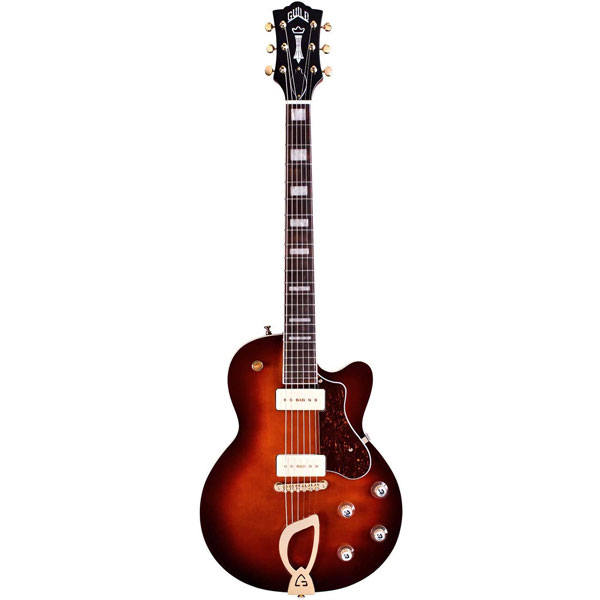
| Estimated Price | $800 |
| Body type | Hollow body, single-cutaway |
| Body material | Spruce and mahogany |
| Neck material | Mahogany and maple |
| Frets | 22 |
| Bridge type | Tune-o-matic with Guild Harp tailpiece |
My Review: But while we’re at Guild Guitars, there’s got to be at least one more of their instruments in this list. However, this time around, we’re looking at something completely different. Guild’s M-75, also known as the Aristocrat, is a hollow-body guitar intended for jazz, RnB, and blues music.
This is a very delicate instrument, intended for some of the finest and smoothest tones you can imagine. And this is not a semi-hollow-body or that Thinline kind of guitar, but rather a full-on jazz-oriented guitar.
The first thing that we can notice is that it has no sound holes, despite having a completely hollow body. Nonetheless, the instrument’s construction lets it resonate well. The body features a laminated spruce top with specially designed bracing on the inside. This is then accompanied by mahogany back and mahogany sides. Such a combination gives the guitar a nice projection.
When combined with Guild’s two Franz P90 pickups, it gives a rather unique tone. Further tone-shaping can be done using two volume and two tone controls, as well as with the standard 3-way pickup selector switch.
The instrument’s body has the classic single-cutaway design. It kind of reminds us of the classic Les Paul body, although it’s much rounder and “softer” in comparison. Nonetheless, you can still notice its great binding and the instrument’s overall vintage appearance that complements its old-school kind of tone.
The guitar’s 3-piece neck, which features mahogany and maple, comes with a rosewood fingerboard, 22 jumbo frets, block inlays, and stylish binding around the fretboard. But what really makes it feel good is the vintage-oriented soft “U”-shaped profile and a set-neck formation, making the guitar feel different compared to the other entries on the list.
Of course, this is all accompanied by top-tier hardware like Grover Sta-Tite and a tune-o-matic bridge with a specially-designed Guild “harp” tailpiece.
From top to bottom, this instrument is a pure jazz masterpiece. You can use it for other stuff, but the guitar, combined with its P90 pickups, is intended for softer tones on clean or overdriven settings. It’s kind of specific, but if you’re looking for such a guitar, you can’t go wrong with Guild’s M-75 Aristocrat.
9. Prestige Guitars NYS Deluxe MG
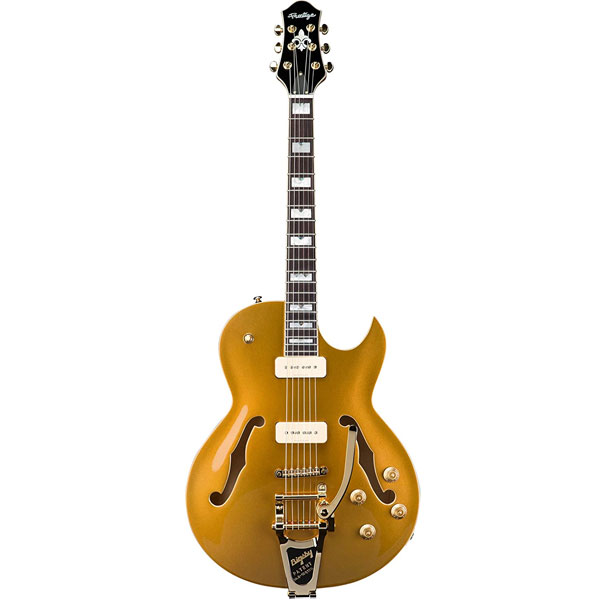
| Estimated Price | $1240 |
| Body type | Semi-hollow body, single-cutaway |
| Body material | Maple |
| Neck material | Mahogany |
| Frets | 22 |
| Bridge type | Tune-o-matic with Bigsby tremolo tailpiece |
My Review: Among so many brands that are present on the market, some stuff tends to get a bit neglected and unrightfully underrated. This is the case with Prestige Guitars, a company that has so much stuff to offer. It’s not like they’re unknown, the brand most certainly has its following, but they could use some more attention. This is why we’re bringing a piece like their NYS Deluxe MG to this list as another awesome guitar with P90 pickups in it.
So let’s start with the pickups. These are two Seymour Duncan P90 variants, the SP90-1N in the neck position and the SP90-1B in the bridge position. Combined with the instrument’s semi-hollow-body construction, it brings some pretty warm and smooth bluesy tones.
Nonetheless, the slight crispiness of the P90s comes through, giving this instrument a pretty great tone and some diversity. It’s not intended for just bluesy and jazzy stuff, but it can also come in handy for classic rock and even some hard rock when used properly.
Of course, the instrument is equipped with four knobs, volume, and tone for each of the pickups, as well as a standard 3-way pickup selector switch, so you’ll have enough parameters to play around with.
The body’s top, back, and sides are all made out of maple. This is then accompanied by a solid maple center block, as well as a mahogany neck, which also vibrates nicely with each note played on the instrument. Then we have a Pau Ferro fingerboard with 20 frets and a total scale length of 24.75 inches.
But what really makes this instrument stand out is its appearance. The arched top, combined with the guitar’s metallic finish, really puts a nice twist to it. We also have two standard “F”-shaped soundholes, as well as binding on the body edges, the fretboard, and the pearl block inlays.
And finally, we get to the instrument’s hardware. Instead of the expected classic tune-o-matic bridge in the style of Gibson guitars, there’s a TonePros Tuneomatic model with rolling saddles. This is accompanied by a Bigsby USA B7 Vibrato tailpiece.
Whether you’re a blues rock-loving enthusiast, a dedicated rockabilly performer, or just about anyone who enjoys the sweet sound and old school appearance of semi-hollow-body guitars, this fine piece by Prestige Guitars will keep you satisfied.
10. Epiphone Wilshire P90
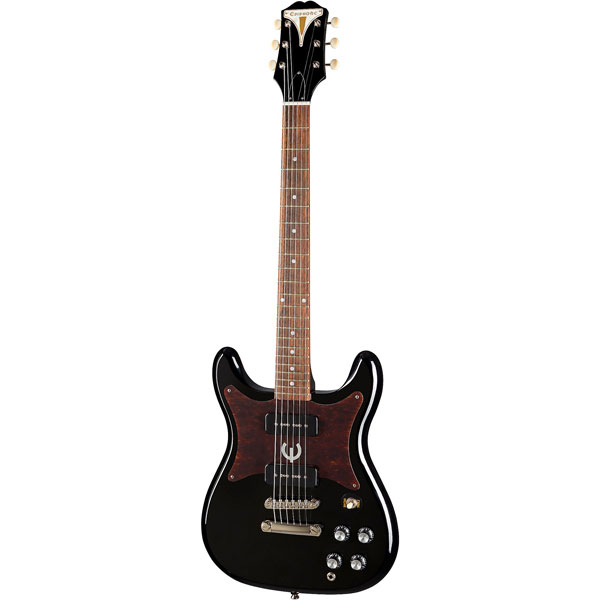
| Estimated Price | $450 |
| Body type | Solid, double-cutaway |
| Body material | Mahogany |
| Neck material | Mahogany |
| Frets | 22 |
| Bridge type | Tune-o-matic |
My Review: Now getting back to Epiphone, we’d like to take a closer look at the company’s Wilshire guitar, the P90 variant. For those who don’t know, the Wilshire model had its original run back from 1959 to 1970. It had a brief return in the 1980s, but Epiphone finally brought it back full-time in 2009.
These were originally symmetrical in shape, very similar to double-cut Les Paul Junior guitars, although with a more square-ish body shape. Their design has changed to an asymmetrical one, but they once again have the symmetry back today.
Essentially, this is one of the simplest P90 guitars that you can find today. At the same time, their quality is at more than just a decent level and they look pretty unique. Combined with the fairly reasonable price tag, we’d say that the Wilshire is more than worth it.
The instrument’s main target group is the punk rock and garage rock population. On the other hand, the guitar is as versatile as a classic double-cutaway Les Paul. What’s really awesome is that they have a glued neck construction and fairly easy access to higher frets.
Aesthetically, these guitars belong to psychedelic rock, punk rock, garage rock, grunge, and other more “laid back” kind of styles. But we’d still recommend it for blues, jazz, even some hard rock or metal if you prefer the P90s over humbuckers.
What’s more, the guitar comes with the classic 4-knob control configuration, which makes it possible to achieve many different types of tones.
Its neck also feels surprisingly great, bearing a “Medium C” type of profile and a 12-inch fretboard radius. Sure, this is not exactly a shred machine, but Wilshire is still a guitar that can work for lead sections as well.
However, the guitar’s design might not sit well with everyone. It’s not bad in any way, but it’s very ’50s or ’60s-oriented. If that works for you, then great! But other than that, this is a fairly simple and effective instrument within a reasonable price limit.
11. Godin 5th Avenue Kingpin P90
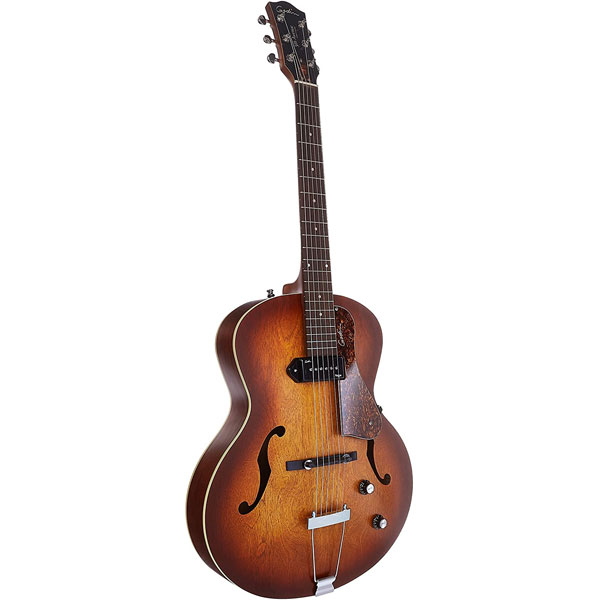
| Estimated Price | $700 |
| Body type | Hollow, no cutaways |
| Body material | Canadian wild cherry |
| Neck material | Silver leaf maple |
| Frets | 21 |
| Bridge type | Graph Tech Tusq |
My Review: A brand that’s not that well-known among enthusiasts, but that professional players adore, Godin has a lot of interesting stuff to offer. Although mostly known for their unique nylon-string guitars with piezo pickups, there’s also some other stuff worth checking out, especially the 5th Avenue series of hollow-body guitars. For this list, we’re bringing a P90-equipped Kingpin model.
It takes no more than just a glance to realize that this is a vintage-oriented instrument. Both its aesthetic and functional features prove that. But what’s really amazing is that the guitar features a body made out of Canadian wild cherry, a material that you don’t see with guitars that often.
The top features the classic arched design, along with two slightly modified yet very stylish “F”-shaped soundholes. This is all followed by a set silver leaf maple neck that has a rosewood fretboard on it, featuring a 16-inch radius.
We could go on for days about this instrument’s wonderful design, something that really captured our attention. But the thing that we’re looking at here is the electronics. The guitar has just one P90 pickup in the neck position.
Needless to say, with such a body design and top-quality materials, its output is the smoothest thing that you’ll ever hear. Well, at least within this ridiculously low price range. It’s followed only by the standard volume and tone controls.
Another thing that really makes the instrument stand out within this price level is the bridge. We have an Adjustable TUSQ variant made by Graphtech. This is also accompanied by a vintage-looking trapeze tailpiece. This rounds up an instrument that’s intended mainly for jazz music, although it comes in handy for other soft-sounding stuff, like some old-school blues or RnB.
Having just one P90 pickup in the neck position and nothing else might feel a bit limiting. However, one of Godin’s main goals here was simplicity and something that would let you shape your tone through different techniques, rather than intricate controls and features.
Again, this is one of the cheapest examples of such an instrument that you can find on the market. Possibly even the cheapest one at this level of quality.
12. Gibson Les Paul Special
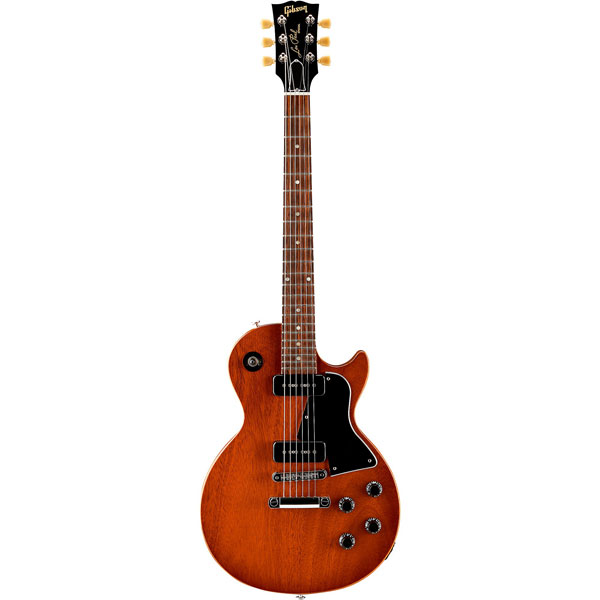
| Estimated Price | $1200 |
| Body type | Solid, single-cutaway |
| Body material | Mahogany |
| Neck material | Mahogany |
| Frets | 22 |
| Bridge type | Tune-o-matic |
My Review: But now we get to the good old stuff. If you want a fully functioning quality P90 guitar with all the classic features and a straightforward approach, then you can’t ever go wrong with Gibson’s Les Paul Special. Whether we’re talking about a variant made back in the old days, or the ones that are manufactured today – it’s all a safe choice.
The model’s been present in the company’s inventory on and off since the 1950s. When Gibson brought them back into production again in 2015, they went with the same classic features. Here we have the standard single-cutaway edition with two P90 pickups in it. Of course, there are also the standard controls that you’d expect on a Les Paul.
But compared to the old versions, this one comes with the regular tune-o-matic bridge with a stop bar tailpiece. It may be a bit of a disappointment to those who prefer to have it all simple and vintage, but it is still more practical this way.
Other than that, the body, neck, headstock, and other parts are what you’d expect from a Gibson Les Paul Special model. Firstly, you can notice that the body has a completely flat top, without any additional tonewoods except for the basic mahogany.
Then there’s the mahogany neck, forming the classic set-in construction and bearing a rosewood fretboard on top of it. It’s all followed by classic traits like the 24.75-inch scale length, a 12-inch fretboard radius, medium-jumbo frets, and classic pearl dot inlays.
On one hand, the guitar isn’t all that exciting. But on the other, it’s what actually makes it awesome. Just like the Epiphone SG Special P90 that we mentioned above, Gibson Les Paul Special has always been about simplicity.
Usually popular among punk rock musicians, we would safely recommend this guitar to blues or even jazz players. It can also be a great choice for hard rock music, and even some old-school metal if it’s accompanied by a nice tube amp and a proper distortion pedal.
It’s simple, to the point, yet very enjoyable to play. It may not look as attractive as a Les Paul Standard or even a Les Paul Studio, but it can be a real “workhorse” guitar that gets the job done.
13. Malinoski HiTop P90
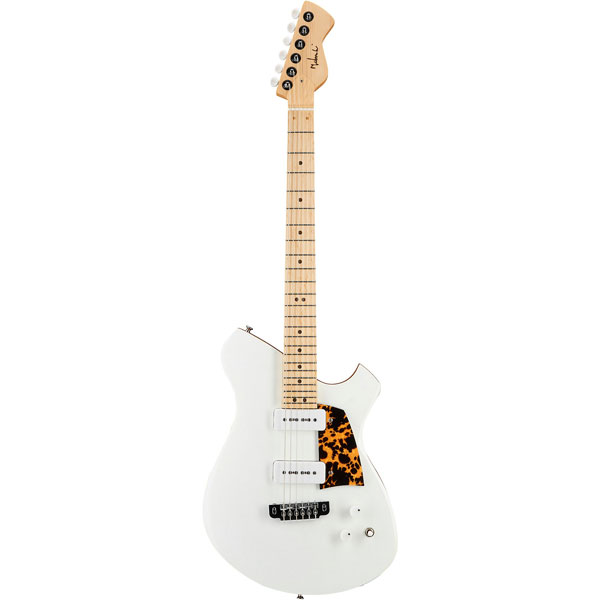
| Estimated Price | $3000 |
| Body type | Solid, “offset” double-cut |
| Body material | Mahogany |
| Neck material | Maple |
| Frets | 24 |
| Bridge type | Fixed |
My Review: While you don’t see them as nearly as often compared to other brands mentioned here, Malinoski guitars are some of the best that money can buy these days. These are generally custom-made instruments and the company is more like a smaller luthier shop focusing on vintage-oriented guitars and basses but with a very stylish twist to them.
If we’re talking about guitars with P90 pickups in them, then Malinoski’s HiTop P90 model is worth checking out. But before we get into it, you should bear in mind that these are top-end expensive instruments with a very unique design.
Just like the company’s other stuff, we can safely say that the HiTop P90 model has a limited target group of users, although it’s a pretty awesome instrument.
Firstly, you can notice the instrument’s pretty unique design. The body is like an artistic and tasteful modification of a classic Telecaster shape. The headstock design also stands out, making the whole instrument look like it’s from a painting. Sure, it’s not for everyone, but we can’t deny the instrument’s greatness.
It features a mahogany body bolted onto a maple neck with a maple fingerboard. The scale length is typical of Fender guitars, measuring 25.5 inches. Meanwhile, the fretboard has 24 frets and a radius of 12 inches. This is all rounded up with a dual-action truss rod, which can give a bit more options for setups.
While we could list the instrument’s features on and on, the most important thing is that the HiTop P90 feels pretty great. It’s a weird combination of vintage and modern elements. On one hand, we have two P90 pickups and a wraparound Gotoh bridge.
On the other, the instrument has a futuristic design and some great ergonomic features. It isn’t a cheap one, but we can’t really complain about it when we look at all the qualities that it has to offer.
As Peter Malinoski himself explains, the guitar is more of a “muscle car,” focusing more on power rather than speed. But to be fair, the instrument can pull both of these things easily. It sounds huge and it plays well. If the budget isn’t an issue and you want a P90 guitar that rocks, then you should definitely consider this one.
14. Epiphone Casino
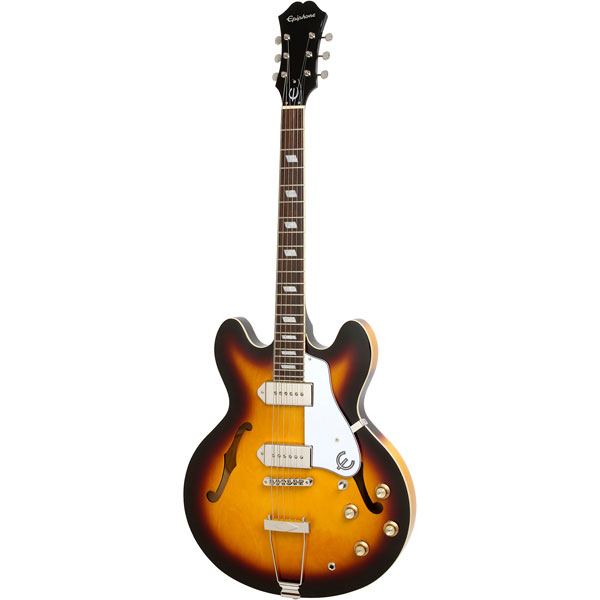
| Estimated Price | $650 |
| Body type | Hollow, double-cutaway |
| Body material | Maple |
| Neck material | Mahogany |
| Frets | 22 |
| Bridge type | Tune-o-matic with trapeze tailpiece |
My Review: But while we’re at Epiphone, the brand is well-known for their Casino guitar. Making its debut in 1961, the guitar has been in constant production since then, which you can’t really say about many models. Even the legendary Les Paul had its breaks early on.
The Casino comes as one of the first Epiphone’s models that came into production after the brand was acquired by Gibson. The guitar was based on Gibson’s ES-330 and is almost identical to it in appearance. The only notable aesthetic difference is the headstock design. But what made Casino and ES-330 so special is the fact that they’re fully hollow-body guitars.
Sure, technically they’re “Thinline” instruments, meaning that they are much thinner than usual hollow-body guitars. But on the other hand, there’s no additional center block in between the bass and treble side of the body. The most important thing here is that Casino has always been a cheaper variant to Gibson’s ES-330.
If we were to be completely honest, you won’t notice much difference between these two guitars. So it’s a much better deal to get an Epiphone Casino if you want a great hollow-body instrument.
That’s at least what John Lennon, Keith Richard, Paul McCartney, and a few other guitar legends have thought. But seriously, if you love the vintage-oriented bluesy stuff, you can’t go wrong with Epiphone Casino.
The guitar’s body is made out of maple, with the arched top being a 5-ply layered maple piece. As expected, the neck is a mahogany one, although it has a Pau Ferro fingerboard. But what we thought was really awesome was the neck profile, the SlimTaper “D”-shaped one.
Combined with the classic 12-inch fretboard radius and a glued neck, it makes for one fairly comfortable guitar to play.
Finally, we have two P90 pickups. These are Epiphone’s Dogear P-90T Classic and Dogear P-90R Classic, which are accompanied by classic Gibson controls (four knobs and a pickup selector switch). It’s one of the most obvious choices for all the blues players who love P90 pickups.
Then again, we think that the instrument can do way more than that, even covering some heavier-sounding stuff. And comparing it to some of Gibson’s high-priced instruments, Casino comes as a much better deal here.
15. Fender Noventa Jazzmaster
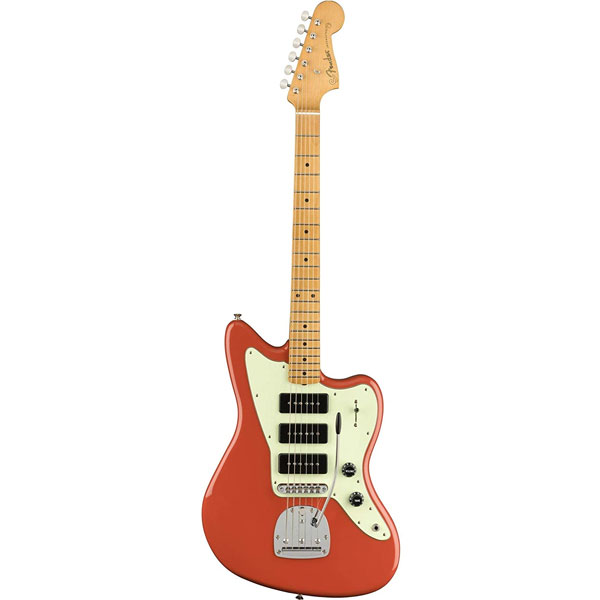
| Estimated Price | $1150 |
| Body type | Solid, Jazzmaster shape |
| Body material | Alder |
| Neck material | Maple |
| Frets | 21 |
| Bridge type | Adjusto-Matic with vintage floating tremolo tailpiece |
My Review: We know what you’re thinking. Fender on a list of P90 guitars? Well, with the resurgence of these old classic “offset” models, some of them got reinforcement in the form of P90 pickups. For instance, classic Jazzmasters had pickups that looked like Gibson’s P90s but were technically just regular single-coils.
But with the Noventa series, Jazzmasters come with Fender’s own take on these pickups, the MP-90 ones. These are new, but they’re based on the same principles that P90s are known for. It’s a single-coil pickup with a powerful and slightly softer output.
But Fender Noventa Jazzmaster is a pretty unique guitar. In some ways, we could say that it’s comparable to Fender’s whole Parallel Universe thing with those unusual guitars. Although it bears that now-classic offset body shape, we can find some pretty unexpected traits on it.
Most importantly, the guitar comes with three of these MP-90 pickups. Things get even more exciting with a 5-way pickup selector switch, allowing for a lot of versatility. Aside from that, the guitar has a volume and a tone knob.
Then for the bridge, we have the so-called “Adjusto-Matic” one, which is pretty much similar to the tune-o-matic design. On the other hand, the bridge is accompanied by a vintage-style floating tremolo tailpiece.
This is the kind typical of Jazzmaster and Jaguar guitars. In addition to this, it’s important to note that the guitar comes with an alder body, maple neck, and a Pau Ferro fretboard.
Overall, the Noventa Jazzmaster comes with a very genuine feel, very similar to the regular old-school Fender Jazzmaster guitars. But with these three MP-90 pickups, you technically get a completely different instrument, a type that you don’t find these days at all.
To be fair, there’s hardly anything to compare it to. However, it’s a great choice if you’re into blues, psychedelic rock, and jazz. However, once again, we have a very potent instrument that comes in handy for plenty of different genres.
16. Fender Player Mustang 90
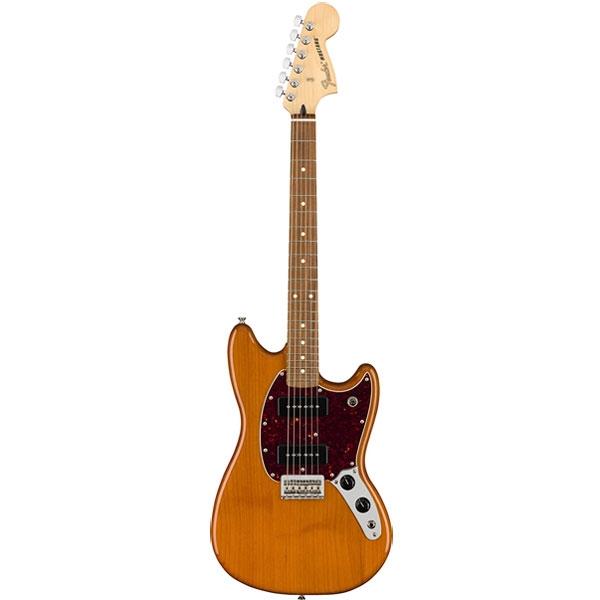
| Estimated Price | $650 |
| Body type | Solid, Mustang |
| Body material | Alder |
| Neck material | Maple |
| Frets | 22 |
| Bridge type | 6-saddle fixed |
My Review: Fender is easily the most popular brand among the lovers of “offset” guitars. And, in our opinion, these aesthetics go perfectly hand-in-hand with P90 pickups. Here we’re looking at Fender Player Mustang 90.
The Player series is essentially the continuation of classic Mexican-made Fender guitars, only with a slightly improved build quality. Comparable to the aforementioned Noventa Jazzmaster, we once again have a guitar with Fender’s MP-90 pickups. The main difference here, though, is that the guitar comes with only two of these P90 copies.
This is also accompanied by a simple 3-way pickup selector switch and your regular volume and tone controls. With that said, the tone is pretty similar to other guitars with these same pickups, like the Noventa series, although you don’t get the same versatility as with the Noventa Jazzmaster.
Other than that, this guitar brings some classic features that you’d expect from a Mustang. There’s the classic body design with alder used as the main build material. Then we have a bolted-on maple neck that has a Pau Ferro fretboard on it with 22 medium-jumbo frets.
What’s very interesting is that the fretboard radius measures 9.5 inches, which makes it feel like those old vintage Fenders. Along with the classic “C”-shaped neck profile, you can get a pretty good grip on it, especially for playing different types of chords.
It also comes with a scale length of 24 inches, which is slightly shorter and typical of Fender Mustang guitars.
Overall, Fender Player Mustang 90 is the best choice for those who are looking for a slightly smaller instrument and something that feels stable with the fretting hand. While it’s not a virtuoso kind of instrument, it’s still a very useful one for classic punk rock and rock stuff.
Again, it’s another great example of a simple guitar with P90 pickups, especially because it also comes with a regular Fender hardtail bridge with bent steel saddles and strings going through the body.
Additionally, it’s also pretty affordable, although you’ll get the same basic qualities as other Fender guitars. It’s a great choice if you prefer to keep it simple and still have that “offset” aesthetic.
17. Fender Noventa Stratocaster
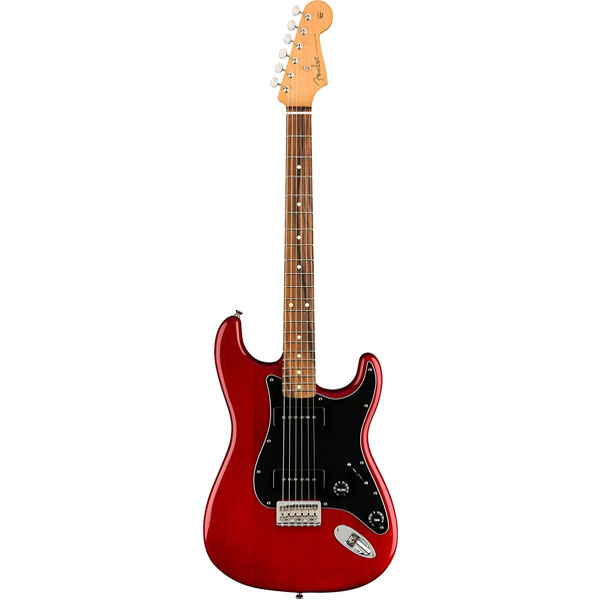
| Estimated Price | $1050 |
| Body type | Solid, Stratocaster |
| Body material | Alder |
| Neck material | Maple |
| Frets | 21 |
| Bridge type | 6-saddle fixed |
My Review: Another one from the Noventa series, here we’re looking at Fender’s new and somewhat unusual take on the legendary Stratocaster model. But although it’s unconventional, the guitar has a lot of qualities worthy of praise, especially within this price level.
If you’re a fan of P90 pickups but you still prefer to have the great feel and design traits of classic Stratocasters, then this Noventa Strat is the way to go. In our opinion, the best part here is that you get the same kind of a maple neck with a maple fingerboard.
That same “twang” and the feel of a 9.5-inch fretboard with a “C” profile are like on any other classic Strat.
Then this all comes with two P90 pickups. In some ways, this is the best of two worlds. You get the performance of Stratocasters with that “beefiness” of classic Gibson and Epiphone guitars with P90 pickups. In some ways, we could call it a “mutated” Les Paul Junior double-cut if you will.
There’s the 3-way pickup selector switch, as well as tone and volume pots. Then again, you have some classic Strat traits, like the output jack placement and the classic Fender-style hardtail bridge with regular saddles.
Although you have fewer options compared to the regular Fender Strat, this guitar is as versatile as it gets. The MP-90 pickups get you pretty much anywhere, even into some heavier territories. Additionally, the guitar feels the same as any other Stratocaster, making it good even for some faster and more demanding lead sections.
Again, it’s the best of two worlds, combining the thick tones of Gibson, some “twang” of Fender guitars, as well as the great feel and ergonomic features of classic Strats.
(Honorable Mention) 18. Guild Guitars T-Bird ST P90
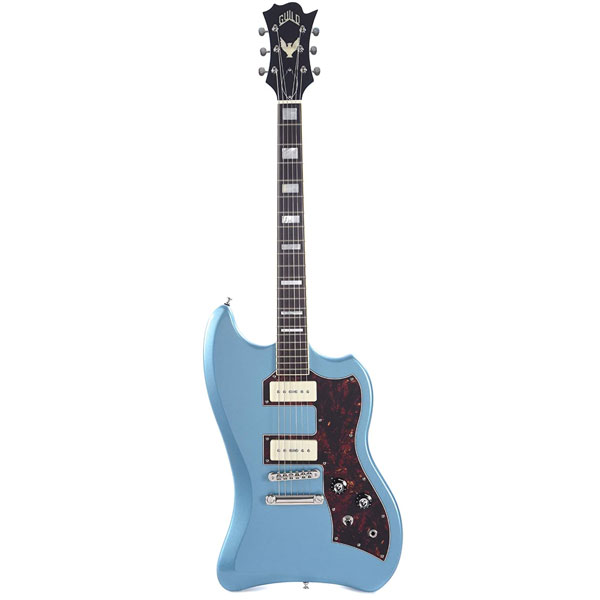
| Estimated Price | $720 |
| Body type | Solid, T-Bird |
| Body material | Mahogany |
| Neck material | Mahogany |
| Frets | 22 |
| Bridge type | Tune-o-matic |
My Review: Seeing the qualities of Guild guitars, we can’t help but mention at least one more of their models here. But compared to the previous two models that we mentioned, here we have a simpler and more “conventional” electric guitar in terms of the basic performance features.
But on the other hand, T-Bird ST P90 has a very unique design, something you don’t see with any other model on the market. It has that “wiggly” T-Bird ST body shape based on the S-200 reissue model, which is kind of difficult to describe.
But what’s important is that the body and neck joint, as well as the unusual cutaways, give pretty easy access to higher frets. This is also accompanied by a weird-looking headstock. Sure, it may not be for everyone’s tastes, but we really like how tasteful yet unique it is.
On the other hand, the pickup layout is simple, with two Franz P90s in the neck and bridge positions. Then there’s the standard tune-o-matic bridge with a stop bar tailpiece. The S-200, on the other hand, comes with a vintage tremolo tailpiece in the style of Jazzmasters. But we prefer it this way as it’s much simpler.
It’s a very potent guitar capable of covering a lot of different styles. Aside from the great pickups and awesome ergonomic qualities, you get some very stylish aesthetic features, including the binding on the fretboard. It’s a great choice for anyone who needs a diverse instrument with P90 pickups that still looks unique.
What You Need to Know About P90 Guitars (Buying Guide)
For those who don’t know, P90 pickups were first introduced in 1946 by Gibson. Other companies have also explored this concept over the years, but Gibson’s P90 pickups are still the go-to variant, especially for the lovers of vintage tones.
While Seymour Duncan is one of the best-known manufacturers aside from Gibson, other big names have also explored this concept and delivered their versions, including Fender, Godin, Gretsch, and many others.
Although a single-coil pickup, featuring the same basic construction as any others out there, there are a few important traits that make it different. Firstly, the bobbin of P90 and similar pickups is shorter and wider. Additionally, the P90 pickup has wiring that’s a bit further away from the individual pole pieces, which, in the end, impacts the tone.
While we’re at it, P90 pickups come with a similar type of brightness as single-coils, although they’re not as “crispy” compared to what you hear with conventional Fender Stratocasters and Telecasters.
While not exactly like a humbucker either, it does have some of the “beefiness” that are more typical of dual-coil pickups. Overall, the tone of P90 pickups is “fatter” and “rounder,” while there’s still some significant influx of higher-ends that’s not present with humbuckers. In some ways, it’s an “in-between” solution for present-day guitar players.
Another very important trait of P90 pickups is that they come with more turns of wire compared to regular single-coil pickups. As opposed to 7500 to 8000 turns, P90s come with around 9500 or 10000. For this purpose, manufacturers use 42 or 43 gauge wire, which is 0.0028 or 0.0024 inches in diameter respectively.
Aside from a stronger output and its unique kind of tone, the mains hum of P90 pickups is more noticeable in the mix compared to standard single-coils. There have been some solutions to these problems, although it mostly comes down to stuff that changes the basic tone of the P90s. On the other hand, some modern solutions have managed to bypass the problem while keeping most of the desirable sonic qualities of a P90 pickup.
But even with this additional hum, P90 pickups still remain quite popular. Their practical use is so wide and goes way past blues and jazz music which they’re usually associated with. In fact, an overlooked fact is that heavy metal music was developed using P90s since Black Sabbath’s Tony Iommi used a Gibson SG Special with these kinds of pickups.
These days, the P90 pickups can find their way into almost any musical style. Their bright and slightly crisp tone, combined with stronger output and some bottom-ends in the mix, goes a long way. Blues, jazz, hard rock, psychedelic rock, and quite often punk musicians are often keen on using P90s. They’re simple, to the point, yet they manage to bring a lot of versatility when combined with suitable amps and pedals.
There are three basic design types for the P90 pickup. There’s the classic plain “Soap bar” that you see on most of Les Paul’s and SGs. The mounting screws here are located within the coils. Then there’s the so-called “Dog ear” variant that has a casing with mounting screws on the side, away from the coils. And the third option includes a humbucker-like casing. They can also come with external mounting screws, but they’re not as common as the previous variants.

My name is Chris and I’ve had a passion for music and guitars for as long as I can remember. I started this website with some of my friends who are musicians, music teachers, gear heads, and music enthusiasts so we could provide high-quality guitar and music-related content.
I’ve been playing guitar since I was 13 years old and am an avid collector. Amps, pedals, guitars, bass, drums, microphones, studio, and recording gear, I love it all.
I was born and raised in Western Pennsylvania. My background is in Electrical Engineering, earning a Bachelor’s degree from Youngstown State University. With my engineering experience, I’ve developed as a designer of guitar amplifiers and effects. A true passion of mine, I’ve designed, built, and repaired a wide range of guitar amps and electronics. Here at the Guitar Lobby, our aim is to share our passion for Music and gear with the rest of the music community.

First two are not P90s. D’angelico is stacked humbuckers in a P90-style cover. Jazzmasters have jazzmaster p-ups, which are their own thing (nor do P90s fit).
Can’t believe that the Yamaha Revstar RS20t isn’t featured in this article. Almost criminal. Amazing quality and amazing sound.